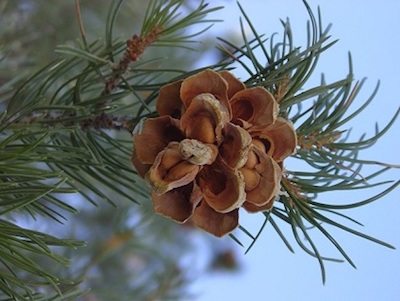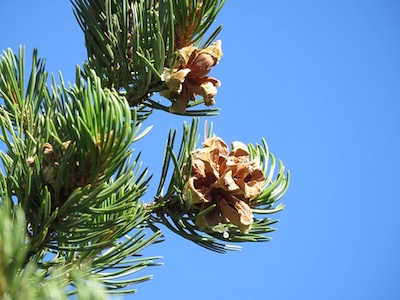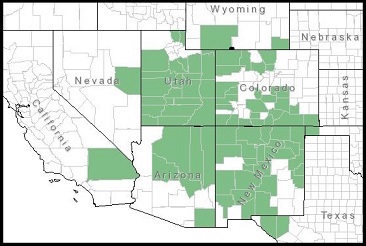 “A pine cone sticky with resin displays pine nuts on a two-needle Pinyon Pine,” according to the National Park Service. (The photo, taken at the Parashant National Monument, was provided by the National Park Service.) A tree with multiple names and different spellings is well known throughout Grant County and New Mexico.
“A pine cone sticky with resin displays pine nuts on a two-needle Pinyon Pine,” according to the National Park Service. (The photo, taken at the Parashant National Monument, was provided by the National Park Service.) A tree with multiple names and different spellings is well known throughout Grant County and New Mexico.
The Piñon Pine (also known as the “Pinyon Pine”) Tree is the state tree of New Mexico.
This tree provides the source of the names for Pinon Street in Santa Clara as well as Pinon Lane and Pinon Street in Silver City. In addition, there is the Pinon Loop Trail in the Gila National Forest.
Beyond these “Pinon” roadways, there is also Pine Street in Santa Clara; Pine Street in Bayard; and Pine Street and Pine Loop in Silver City.
 A number of pine nuts were found within these Pinyon Pine Tree cones by Mr. Matthew Eckler. (The photo, taken in New Mexico in September of 2015, was provided by Mr. Eckler through Flickr.)The scientific name for the Piñon Pine Tree is “Pinus edulis,” according to the Natural Resources Conservation Service of the USDA. The governmental agency indicated that among the tree’s common names – beyond “Piñon Pine” and “Pinyon Pine” – are “Two Needle Pinyon” and “Nut Pine.”
A number of pine nuts were found within these Pinyon Pine Tree cones by Mr. Matthew Eckler. (The photo, taken in New Mexico in September of 2015, was provided by Mr. Eckler through Flickr.)The scientific name for the Piñon Pine Tree is “Pinus edulis,” according to the Natural Resources Conservation Service of the USDA. The governmental agency indicated that among the tree’s common names – beyond “Piñon Pine” and “Pinyon Pine” – are “Two Needle Pinyon” and “Nut Pine.”
Others simply call the tree “Piñon.”
Piñon Pine Trees have been interwoven into the culture of America’s Southwest and Rocky Mountain regions.
“Eaten raw, roasted, or ground into flour, pine nuts were a staple of the Native American diet,” according to the National Park Service. “Pine needles were also used for tea and in years when there was no other food, the inner bark was eaten to survive starvation conditions.”
The National Park Service detailed that “Twenty to forty dark red male cones will grow in clusters at the end of the branches, while in female trees a solitary cone will form. Reproduction occurs by wind pollination and new seeds or pine nuts will not mature until the year following fertilization.”
According to a statement from the New Mexico Office of the Secretary of State, “Few plants or animals are more ingrained in the culture and biology of New Mexico than the Piñon Pine.”
“The species grows very slowly, often in more dry habitats in the mountains at an elevation of 4,500 up to about 8,000 feet,” the statement from the Secretary of State continued. “The adult trees are usually within 15-35 feet tall. The round to ovate cones are distinctive…Jays, especially Piñon Jays depend heavily on nuts of this plant and even help to spread the plant by caching deposits of seeds. Piñon wood warms New Mexicans across the state and give off a distinctive and very pleasant incense smell.”
Beyond New Mexico, nine other states have some type of Pine tree as their state trees. In Nevada, for example, the Single-Leaf Piñon (Pinus monophylla) Tree is the state tree.
Not everyone thinks highly of the Pinyon Pine Tree – whether it be of the single-leaf or two needle varieties. Among those who see this type of tree as a problem is one division of the Federal government.
In a number of areas of the country, the Bureau of Land Management (BLM) is purposely killing these trees.
“The Bureau of Land Management Ely District’s fuels staff is hand-thinning and masticating pinyon-pine and juniper trees in the Black Canyon and Nine-mile Summit areas of the Egan Basin, about 50 miles north of Ely [Nevada],” according to a statement issued by the Federal government in November of 2019.
“Tree thinning is one of several treatment options to be utilized as part of the Egan and Johnson Basins Restoration Project that was designed to reduce catastrophic wildfire risk and improve watershed health in the Egan Basin by restoring sagebrush and other communities, including the pinyon-juniper woodlands,” the statement from the BLM continued.
Not all divisions of the Federal government share the vision of the BLM.
According to a report from the Rocky Mountain Research Station of the United States Forest Service, Pinyon and Juniper trees are “the most common forest type, accounting for 48 percent of the forest land” within the Gila National Forest. This means, according to this report using data from 1994, that these varieties of trees are “the predominant tree species in a stand, based on plurality of tree stocking. Stocking is an expression of the extent to which growing space is effectively utilized by live trees.”
 This map shows where the Piñon Pine (the two needle variety) grows throughout the Southwestern and Rocky Mountain areas of the United States. (Map was provided courtesy of the National Plant Data Team of the Natural Resources Conservation Service of the USDA, 2018.)Only the Gambel Oak Tree is more common within the Gila National Forest than the Pinyon Pine Tree. The report from the Rocky Mountain Research Station indicated that about 19% of all live trees in the Gila National Forest are Pinyon Pine Trees. This tree is commonly found in most of the counties in New Mexico, including Grant County.
This map shows where the Piñon Pine (the two needle variety) grows throughout the Southwestern and Rocky Mountain areas of the United States. (Map was provided courtesy of the National Plant Data Team of the Natural Resources Conservation Service of the USDA, 2018.)Only the Gambel Oak Tree is more common within the Gila National Forest than the Pinyon Pine Tree. The report from the Rocky Mountain Research Station indicated that about 19% of all live trees in the Gila National Forest are Pinyon Pine Trees. This tree is commonly found in most of the counties in New Mexico, including Grant County.
Do you have questions about communities in Grant County?
A street name? A building?
Your questions may be used in a future news column.
Contact Richard McDonough at chroniclesofgrantcounty@gmail.com.
© 2020 Richard McDonough


